 |
February 2, 2004
| Shoe Fetish, Part III |
The subject of shoes as possible evidence of Amelia Earhart’s presence on Nikumaroro has been a recurring theme in TIGHAR’s investigation, but that is hardly surprising. Shoes, and particularly the soles and heels of shoes, are often the items of clothing that survive when everything but bones has disappeared. Questions about shoes have played such a key role in The Earhart Project that the book authored by TIGHAR researchers Dr. Tom King, Dr. Karen Burns, Dr. Randy Jacobson and Mr. Kenton Spading is titled Amelia Earhart's Shoes.
This is the third research bulletin on the TIGHAR website to address the issue of Earhart’s shoes, what we know about them. and how they may or may not fit with evidence found on Nikumaroro. The first bulletin was written in February 2001. It described the shoe parts found during TIGHAR’s 1991 expedition and explained why we suspected that they might be the remains of Earhart’s shoes.
The second bulletin, written two months later, sought to catalog what shoes Earhart is known to have had with her on her World Flight and examine how they compare with the artifacts found on the island. Our conclusion at that time was that we needed more information before we could draw any conclusion.
Now, three years later, we have more information and we’re able to draw some conclusions. Some of the new information has come through hard-slogging archaeological work on Nikumaroro but, ironically, some of it is photographic information that we’ve had all along but simply hadn’t interpreted correctly.
The best sources of information we have about what shoes Amelia Earhart
actually had with her on the second World Flight attempt are the dozens
of photos taken of her during the trip. Those photos show the three pairs
of shoes described below as Pairs #1, 2, & 3.
A newspaper interview published in the New York Herald Tribune on March 7, 1937 (ten days before the departure of the first World Flight attempt) reports that, “In the plane she’ll wear light, low shoes. And this time she’s taking along a pair of heavy, high walking boots ‘just in case,’ as she puts it.” However, no heavy, high walking boots appear in any of the photos taken during the World Flight. The possibility remains that such boots were stowed aboard the aircraft for emergency use but the inventory of items aboard the plane taken after the Luke Field accident does not include any footwear.
A passage in Last Flight, in the chapter entitled “Fortaleza and Natal,” describes the clothing she took along on the second World Flight attempt:
My wardrobe included five shirts, two pairs of slacks, a change of shoes, a light working cover-all and a trick weightless raincoat, plus the minimum of toilet articles.
But like so much of that heavily-edited book, the verifiable
facts tell a different story. The photos show that she had at least two
“changes of shoes” with her.
Pair #1
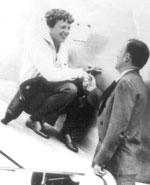
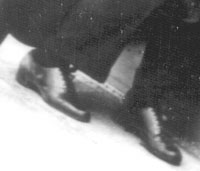
Earhart bids her husband goodbye in Miami, June1937. Pair #1 were low-cut blucher oxfords with a smooth toe, tasseled laces, and unusual two-tone heels. (More about the two-tone heels later.)
Photo courtesy Purdue University Library Special Collections.
Pair #2


Earhart with refueling funnel in Bandoeng, Java, June 1937. Pair #2 were low-cut blucher oxfords identical to Pair #1 except for a capped toe.
Photo courtesy Purdue University Library Special Collections.
Pair #3

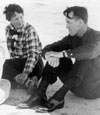
Earhart watches maintenance, date unknown. Pair #3 were a style known then, and now, as “spectator shoes.”
Below, Earhart and Noonan under the tail of the Electra
in Miami, late May, 1937. The soles and heels of Pair #3 appear to be
a single molded piece of light colored material.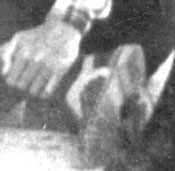
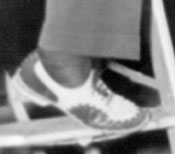
Photos courtesy Purdue University Library Special Collections.
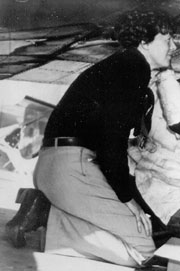 The
key to evaluating the shoe parts we found on Nikumaroro was the realization
that the bottom portion of the heels on Earhart’s blucher oxfords (Pairs
# 1 & 2) were quite distinctive.
The
key to evaluating the shoe parts we found on Nikumaroro was the realization
that the bottom portion of the heels on Earhart’s blucher oxfords (Pairs
# 1 & 2) were quite distinctive.
The photo at right, taken prior to the first World Flight attempt, is the only one we’ve found that shows a clear view of the underside of Earhart’s blucher oxford shoes.
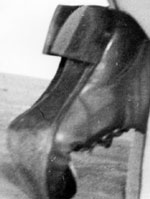 Although
we can’t be certain whether the shoes in the photo are Pair #1 or
Pair #2, we can very clearly see that the underside of the heel is a composite
structure that is dark colored on the distal (outside) two-thirds and
light colored on the medial (inside) third.
Although
we can’t be certain whether the shoes in the photo are Pair #1 or
Pair #2, we can very clearly see that the underside of the heel is a composite
structure that is dark colored on the distal (outside) two-thirds and
light colored on the medial (inside) third.
 Removing the background clutter and tracing the outlines of the heel makes
the photo easier to understand.
Removing the background clutter and tracing the outlines of the heel makes
the photo easier to understand.
For a long time we assumed that the light/dark appearance of the heel in the above photo was a function of light and shadow but the photo below, taken in early March 1937, confirms the two-tone nature of the heel The shoes are Pair #2 (note the toecap) and the boundary between the dark and light portions of the heel bottom is distinct and separate from the shadow cast by the sole.
Photos courtesy Purdue University Library Special Collections.
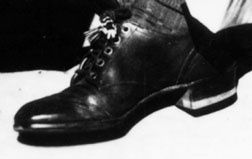 With
an understanding of what the heels looked like we can go back through
all of the photos taken before and during the World Flight and see that,
with 100% consistency, whenever we can see the distal side of Earhart’s
blucher oxfords (Pair #1 or Pair #2) the bottom part of the heel is dark.
Whenever we can see the medial side, the bottom part of the heel is light
colored. Neither of the heels found by TIGHAR on Nikumaroro has this unique
construction. As shown above, Earhart’s Pair #3 appears to have had
a light colored one-piece sole and heel. We can therefore safely conclude
that the shoe parts we found did not come from any of the three pairs
of shoes Earhart is known to have had with her.
With
an understanding of what the heels looked like we can go back through
all of the photos taken before and during the World Flight and see that,
with 100% consistency, whenever we can see the distal side of Earhart’s
blucher oxfords (Pair #1 or Pair #2) the bottom part of the heel is dark.
Whenever we can see the medial side, the bottom part of the heel is light
colored. Neither of the heels found by TIGHAR on Nikumaroro has this unique
construction. As shown above, Earhart’s Pair #3 appears to have had
a light colored one-piece sole and heel. We can therefore safely conclude
that the shoe parts we found did not come from any of the three pairs
of shoes Earhart is known to have had with her.
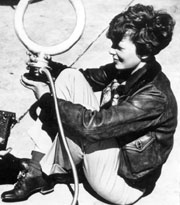 So
what DID we find? What was a woman’s blucher oxford shoe with a 1930s
vintage American replacement heel doing on Nikumaroro? There remains the
possibility that it is an Earhart shoe that does not appear in any of
the photos but it is perhaps more plausible that the identification of
the sole as being from a woman's shoe – a judgment based only on the
tightness of the stitching holes – (see A
Shoe Fetish, Part 1) was in error.
So
what DID we find? What was a woman’s blucher oxford shoe with a 1930s
vintage American replacement heel doing on Nikumaroro? There remains the
possibility that it is an Earhart shoe that does not appear in any of
the photos but it is perhaps more plausible that the identification of
the sole as being from a woman's shoe – a judgment based only on the
tightness of the stitching holes – (see A
Shoe Fetish, Part 1) was in error.
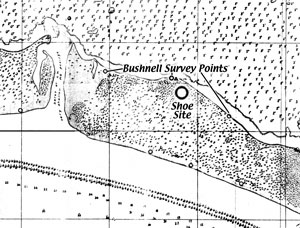 The
presence of a man’s 1930s vintage blucher oxford shoe with an American
replacement heel might be attributed to the November 1939 survey of the
island by personnel from the USS Bushnell. The map of the island
that resulted from that survey shows that one of the observation points
used was on the lagoon shore just a few hundred feet from where the shoe
parts were found.
The
presence of a man’s 1930s vintage blucher oxford shoe with an American
replacement heel might be attributed to the November 1939 survey of the
island by personnel from the USS Bushnell. The map of the island
that resulted from that survey shows that one of the observation points
used was on the lagoon shore just a few hundred feet from where the shoe
parts were found.
The Other Shoe Discovery
But the shoe parts found by TIGHAR in 1991 were not the first time such artifacts had found on Nikumaroro and attributed to Amelia Earhart. In 1940 British colonial officer Gerald Gallagher found shoe parts with the bones he suspected might be Earhart’s. In his various communications with his superiors he described what he found this way:
part of a shoe … Shoe was a womans and probably size 10 – Telegram September 23, 1940 Only part of sole remains … Appears to have been stoutish walking shoe or heavy sandal Telegram October 6, 1940 my conclusion [that the bones were those of a woman] based on sole of shoe which is almost certainly a woman’s. Telegram October 17, 1940
With only “part of a sole” to go on, why was Gallagher so sure that it was woman’s shoe?
- He makes no mention of a heel, but a high heel would not be characteristic of a “stoutish walking shoe or heavy sandal” anyway.
- He says the shoe was “probably size 10.” British shoe sizes make no gender distinction. A British size 10 shoe, male or female, is roughly equivalent to a modern U.S. men’s size 10, so Gallagher was not basing his opinion on the partial sole’s size.
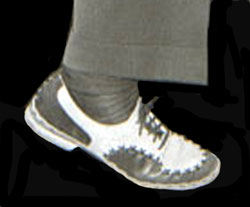 Could Gallagher have been looking at the partial sole of
Earhart's Pair #3 spectator shoes?
Could Gallagher have been looking at the partial sole of
Earhart's Pair #3 spectator shoes?
- In 1940 a light colored sole could reasonably be assumed to be from a woman’s shoe.
- The one-piece sole and heel molded construction of Pair #3 is typical of that seen in “stoutish walking shoes or heavy sandals.”
There is, of course, no way to know for sure unless the artifacts that Gallagher found still survive somewhere and can be found, or if the sole of the other shoe awaits discovery on Nikumaroro, but it is noteworthy that Gallagher’s puzzling conclusions are less puzzling if what he found was the partial sole from one of Earhart’s Pair #3 shoes.
